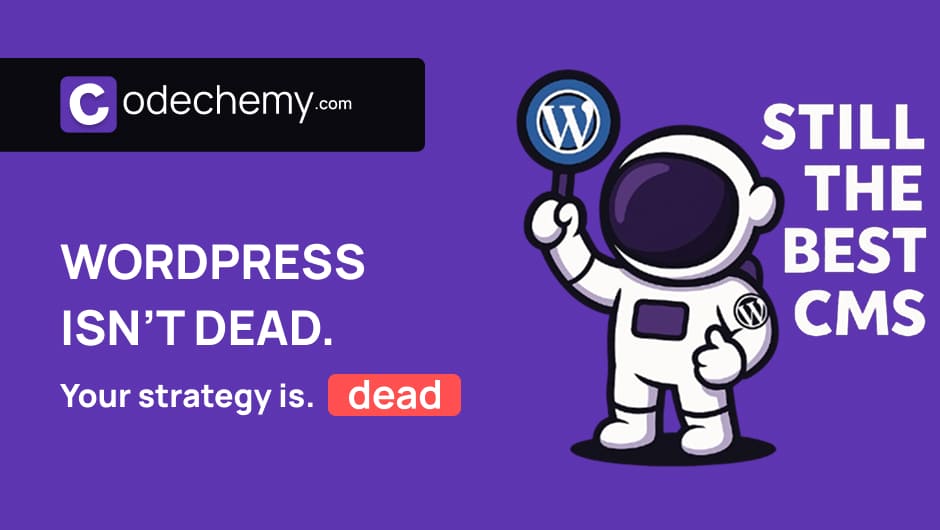Why WordPress is still the best CMS for growing businesses in 2025 isn’t just a hot take — it’s a fact backed by scale, flexibility, and thousands of real-world success stories. Despite a flood of “next-gen” website builders and hyped SaaS platforms, WordPress continues to dominate where it matters: control, cost-efficiency, SEO, scalability, and freedom.
If you’re running or growing a business and debating between platforms, this article is your no-BS breakdown of why WordPress still reigns — especially when compared to platforms like Webflow, Wix, and Shopify.
First, Let’s Look at the Numbers
-
🧱 WordPress powers 43% of all websites (source: W3Techs, Jan 2025)
-
💼 Used by major brands: TechCrunch, BBC, Microsoft News, even Beyoncé
-
🔌 59,000+ plugins, thousands of themes
-
💰 WordPress websites generate billions in revenue globally every year
That’s not a fluke — that’s proven infrastructure. You don’t get this kind of market share by accident.
WordPress vs Webflow: The 2025 Showdown
Let’s address the elephant in the room. Webflow is slick. We like it too — for some use cases. But if you’re scaling a serious business, here’s how the platforms actually stack up.
| Feature | WordPress | Webflow |
|---|---|---|
| Ownership | ✅ Full control | ❌ Locked in Webflow hosting |
| CMS Flexibility | ✅ Custom post types, taxonomies | ⚠️ Limited for complex setups |
| Plugin Ecosystem | ✅ 59k+ plugins | ❌ Very limited |
| SEO Capabilities | ✅ Deep control, schema, sitemaps | ⚠️ Basic built-in SEO |
| Scalability | ✅ Enterprise-ready | ❌ Struggles with big content |
| Cost Over Time | ✅ Self-hosting = lower long-term | ❌ Monthly SaaS fees forever |
| Community & Support | ✅ Massive ecosystem | ❌ Smaller, closed community |
Verdict: Webflow is great… if your business isn’t planning to grow much. But if you’re building something to scale, WordPress wins. Every. Time.
Why WordPress Scalability Matters
wordpress scalability isn’t just a technical buzzword — it’s a business enabler.
You may launch with 5 pages. But what happens when you need:
-
1,000 product pages
-
A multilingual site
-
Custom user roles and dashboards
-
Deep SEO structures
-
CRM, ERP, or API integrations?
WordPress handles that effortlessly. You don’t have to rebuild. You just expand.
Scalable = Sustainable. If you’re serious about growth, you need a platform that won’t break under pressure.
SEO: WordPress Is Still King
Let’s be blunt. SEO isn’t optional anymore. If people can’t find your site on Google, you don’t exist. Here’s where WordPress crushes:
-
✅ Custom meta titles, descriptions, URLs
-
✅ Schema markup via plugins like RankMath
-
✅ Full control over page speed optimization
-
✅ Integration with every major SEO tool (Ahrefs, SEMrush, Screaming Frog)
best cms for business 2025? The one Google loves. And that’s still WordPress.
How WordPress Fits into Modern Business Tech Stacks
Unlike many SaaS CMS platforms, WordPress plays well with:
-
HubSpot, Salesforce, Zoho
-
Stripe, PayPal, Klarna
-
Zapier, Make, n8n
-
Headless setups with GraphQL or REST APIs
Need a PWA? An LMS? A membership site?
You can build all of that without switching CMS — just extend WordPress.
💡 You don’t grow by replatforming every year. You grow by building on a solid base.
But Isn’t WordPress… Outdated?
Let’s kill that myth once and for all.
What people call “outdated” is usually:
-
Poor hosting
-
Bloated themes
-
Bad plugin choices
-
Zero optimization
In the hands of pros, WordPress sites are:
-
💨 Lightning fast (Sub-1.5s load times)
-
🔒 Secure (with the right setup)
-
📈 Optimized to convert
We’ve rebuilt “modern Webflow sites” that crashed at 1,000+ page loads. Meanwhile, our custom WordPress builds handle 100,000+ visits/month without a sweat.
Real Example: Business Website at Scale
Client: B2B SaaS startup
Platform: Switched from Webflow to WordPress
Why:
-
Needed gated content system
-
Webflow couldn’t handle flexible user roles
-
Blog traffic hit a ceiling due to SEO limitations
Result with WordPress:
-
+38% organic traffic in 2 months
-
+4 min avg time on site
-
Rebuilt the same site with Elementor in 40% less time
Total Cost of Ownership: Let’s Talk Money
| CMS | Monthly Cost | Dev Flexibility | Long-Term ROI |
|---|---|---|---|
| WordPress + hosting | $10–$30 | ✅ Full | ✅ High |
| Webflow Business Plan | $39–$60 | ❌ Limited | ❌ Lower |
| Wix eCommerce Plan | $44–$80 | ❌ Very Limited | ❌ Lowest |
What looks cheaper upfront, often costs more in limitations.
What Businesses Actually Need (And WordPress Delivers)
Most growing companies eventually need:
-
Full content flexibility
-
Landing pages with A/B testing
-
CRM integrations
-
Fast loading across devices
-
Scalable architecture
-
Total ownership of their platform
WordPress checks all those boxes. The rest? Half-measures.
When NOT to Use WordPress
Yes, we’re honest.
Avoid WordPress if:
-
You’re building a 1-page portfolio with zero plans to scale
-
You don’t want to touch even a dashboard (go Squarespace)
-
You don’t care about SEO or performance (which… why are you in business?)
Final Checklist: Why WordPress Wins in 2025
| Feature | WordPress |
|---|---|
| Scales with your business | ✅ |
| SEO control + schema + speed | ✅ |
| Full ownership (no platform lock) | ✅ |
| Works with modern SaaS stack | ✅ |
| Thousands of tools + integrations | ✅ |
| Massive community & future-proof | ✅ |
Still think WordPress is outdated?
Then your agency just didn’t use it right.
💼 Ready to Build Smart, Scalable Websites?
Skip the hype. Use what works.
Why WordPress is still the best CMS for growing businesses in 2025 is proven by decades of dominance — and we’re here to help you use it right.
